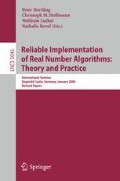Abstract
The unresolved subtleties of floating point computations in geometric modeling become considerably more difficult in animations and scientific visualizations. Some emerging solutions based upon topological considerations for curves will be presented. A novel geometric seeding algorithm for Newton’s method was used in experiments to determine feasible support for these visualization applications.
Access this chapter
Tax calculation will be finalised at checkout
Purchases are for personal use only
Preview
Unable to display preview. Download preview PDF.
References
Amenta, N., Peters, T.J., Russell, A.C.: Computational topology: ambient isotopic approximation of 2-manifolds. Theoretical Computer Science 305, 3–15 (2003)
Bisceglio, J.: Personal communication. justin.bisceglio@gmail.com (October 2005)
Damon, J.: On the smoothness and geometry of boundaries associated to skeletal structures, i: sufficient conditions for smoothness. Annales Inst. Fourier 53, 1941–1985 (2003)
J. Damon.: Determining the geometry of boundaries of objects from medial data (pre-print, 2004)
J. Damon.: Smoothness and geometry of boundaries associated to skeletal structures, II: geometry in the Blum case (pre-print, 2004)
Ellis, R., Gullick, D.: Calculus with Analytic Geometry, 3rd edn., Harcourt Brace Jovanovich (1986)
Farin, G.: Curves and Surfaces for Computer Aided Geometric Design: A Practicle Guide, 2nd edn. Academic Press, San Diego (1990)
Lutterkort, D., Peters, J.: Linear envelopes for uniform B–spline curves. In: Curves and Surfaces, St Malo, pp. 239–246 (2000)
Maekawa, T., Patrikalakis, N.M.: Shape Interrogation for Computer Aided Design and Manufacturing. Springer, New York (2002)
Maekawa, T., Patrikalakis, N.M., Sakkalis, T., Yu, G.: Analysis and applications of pipe surfaces. Computer Aided Geometric Design 15, 437–458 (1998)
Mathews, J.H.: Numerical Methods for Computer Science, Engineering and Mathematics. Prentice-Hall, Inc., Englewood Cliffs (1987)
Moore, E.L.F.: Computational Topology of Spline Curves for Geometric and Molecular Approximations. PhD thesis, The University of Connecticut (2006)
Moore, E.L.F., Peters, T.J., Roulier, J.A.: Preserving computatational topology by subdivision of quadratic and cubic Bézier curves (to appear)
Piegl, L., Tiller, W.: The NURBS Book, 2nd edn. Springer, Heidelberg (1997)
Author information
Authors and Affiliations
Editor information
Rights and permissions
Copyright information
© 2008 Springer-Verlag Berlin Heidelberg
About this paper
Cite this paper
Miller, L.E., Moore, E.L.F., Peters, T.J., Russell, A. (2008). Topological Neighborhoods for Spline Curves: Practice & Theory. In: Hertling, P., Hoffmann, C.M., Luther, W., Revol, N. (eds) Reliable Implementation of Real Number Algorithms: Theory and Practice. Lecture Notes in Computer Science, vol 5045. Springer, Berlin, Heidelberg. https://doi.org/10.1007/978-3-540-85521-7_9
Download citation
DOI: https://doi.org/10.1007/978-3-540-85521-7_9
Publisher Name: Springer, Berlin, Heidelberg
Print ISBN: 978-3-540-85520-0
Online ISBN: 978-3-540-85521-7
eBook Packages: Computer ScienceComputer Science (R0)

